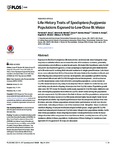Please use this identifier to cite or link to this item:
http://www.alice.cnptia.embrapa.br/alice/handle/doc/1047700| Title: | Life-history traits of Spodoptera frugiperda populations exposed to low-dose Bt maize. |
| Authors: | SOUSA, F. F.  MENDES, S. M.   SANTOS-AMAYA, O. F.   ARAÚJO, O. G.   OLIVEIRA, E. E.   PEREIRA, E. J. G.   |
| Affiliation: | SIMONE MARTINS MENDES, CNPMS. |
| Date Issued: | 2016 |
| Citation: | Plos One, San Francisco, v. 11, n. 5, p. 1-18, May 2016. |
| Description: | Exposure to Bacillus thuringiensis (Bt) toxins in low- and moderate-dose transgenic crops may induce sublethal effects and increase the rate of Bt resistance evolution, potentially compromising control efficacy against target pests. We tested this hypothesis using the fall armyworm Spodoptera frugiperda, a major polyphagous lepidopteran pest relatively tolerant to Bt notorious for evolving field-relevant resistance to single-gene Bt maize. Late-instar larvae were collected from Bt Cry1Ab and non-Bt maize fields in five locations in Brazil, and their offspring was compared for survival, development, and population growth in rearing environment without and with Cry1Ab throughout larval development. Larval survival on Cry1Ab maize leaves varied from 20 to 80% among the populations. Larvae reared on Cry1Ab maize had seven-day delay in development time in relation to control larvae, and such delay was shorter in offspring of armyworms from Cry1Ab maize. Population growth rates were 50?70% lower for insects continuously exposed to Cry1Ab maize relative to controls, showing the population-level effect of Cry1Ab, which varied among the populations and prior exposure to Cry1Ab maize in the field. In three out of five populations, armyworms derived from Bt maize reared on Cry1Ab maize showed higher larval weight, faster larval development and better reproductive performance than the armyworms derived from non-Bt maize, and one of these populations showed better performance on both Cry1Ab and control diets, indicating no fitness cost of the resistance trait. Altogether, these results indicate that offspring of armyworms that developed on field-grown, single-gene Bt Cry1Ab maize had reduced performance on Cry1Ab maize foliage in two populations studied, but in other three populations, these offspring had better overall performance on the Bt maize foliage than that of the armyworms from non-Bt maize fields, possibly because of Cry1Ab resistance alleles in these populations. Implications of these findings for resistance management of S. frugiperda in Bt crops are discussed. |
| Thesagro: | Lagarta Praga de planta Zea mays |
| DOI: | 10.1371/journal.pone.0156608 |
| Type of Material: | Artigo de periódico |
| Access: | openAccess |
| Appears in Collections: | Artigo em periódico indexado (CNPMS)  |
Files in This Item:
| File | Description | Size | Format | |
|---|---|---|---|---|
| Lifehistory.pdf | 1,33 MB | Adobe PDF |  View/Open |









